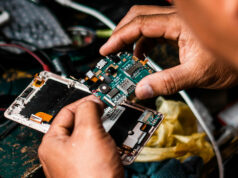Factory expansion slowest in 9 months
MANUFACTURERS in the Philippines marked the smallest improvement in business conditions in nine months as the second quarter began as output growth dropped to a 19-month low, according to the latest monthly survey IHS Markit conducted for Nikkei, Inc. that also showed new orders rose at the weakest rate in nine months and a “sustained fall” in orders from abroad that was “notably faster than that seen in March.”
“Business conditions in the Philippines’ manufacturing sector improved only slightly during April, with production levels increasing at the weakest rate in over one-and-a-half years,” the report read.
“New orders rose solidly, but at the softest pace for nine months, as demand from overseas saw a moderate decline.”
The seasonally adjusted Nikkei Philippines Manufacturing Purchasing Managers’ Index (PMI) fell to 50.9 — signaling “marginal” improvement from the preceding month — in April from 51.5 in March, the weakest reading since July 2018 which saw the same level. Before that point, February 2018 was weaker with 50.8.
April marked the fifth straight month of PMI decline, even as a reading above 50 reflects improvement of business conditions, while those below that mark denotes deterioration.
The PMI data appeared to coincide with declining volume of factory output, as tracked by the government’s Monthly Integrated Survey of Selected Industries (MISSI). Latest MISSI data from the Philippine Statistics Authority (PSA) show such volume growing by a slower 1.3% year-on-year in November last year from October’s 2.3%, and then dropping by 9.3%, 2.8% and 8.5% from December to February, respectively. The PSA is scheduled to report March MISSI results on May 7.
The manufacturing PMI consists of five sub-indices, with new orders having the heaviest weight at 30%, followed by output with 25%, employment with 20%, suppliers’ delivery times with 15% and stocks of purchases with 10%.
April dragged the Philippines further down the list of the seven tracked members of the 10-country Association of Southeast Asian Nations (ASEAN), placing the country fourth — from third in March, second in February and first in January — behind Myanmar, which saw a “solid increase” at 53.7; Vietnam, which saw a “modest increase” at 52.5 and Thailand which at 51 marked a “marginal increase.”
At the same time, the Philippines’ reading still bested that of ASEAN, whose PMI rose to 50.4 in April — the highest in five months — from 50.3 in March.
Output growth among manufacturers in the Philippines was “the second-weakest” since the country’s survey began in January 2016, while sales of manufactured goods increased “at the slowest rate since July 2018”.
The report said “[f]irms responded” to muted improvement in business conditions “by reducing job numbers for the second month running, while also lowering stocks of pre-production goods”.
And with output growth softening further, respondents’ outlook “remained relatively subdued in April, albeit still positive overall”.
“Overall, businesses were positive that that output will increase, with many relating this to forecasts of higher incoming orders, new products and greater company development.”
The report quoted IHS Markit Economist David Owen as noting that while “April PMI revealed an even more subdued picture of the Philippines… There was some positive news… as firms reported an alleviation of import delays due to the recent port congestion in Manila.”
“This led to the first improvement in supplier delivery times in nine months…”
Mr. Owen also said that the May 13 mid-term legislative and local elections could “stifle” manufacturing somewhat, hence, “the second quarter may prove to be a challenging one for the… sector.”
Region-wide, he noted that while manufacturing’s “increase was centered on Myanmar and Thailand… the Philippines continued to record the highest level of positive sentiment, while the weakest degree of optimism was seen in Myanmar.” — Reicelene Joy N. Ignacio




